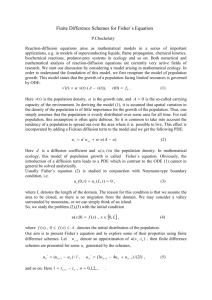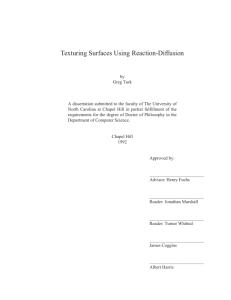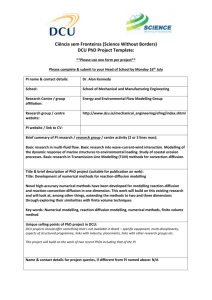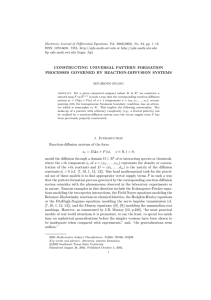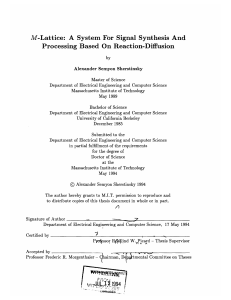How the Leopard Gets Its Spots A single pattern
advertisement
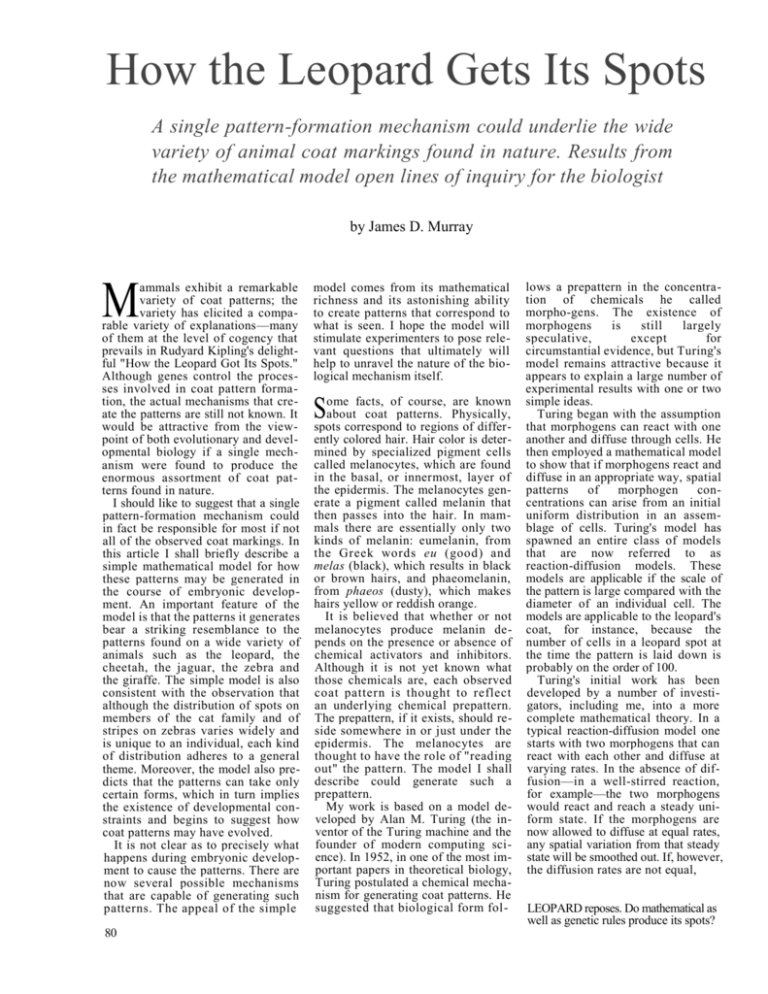
How the Leopard Gets Its Spots
A single pattern-formation mechanism could underlie the wide
variety of animal coat markings found in nature. Results from
the mathematical model open lines of inquiry for the biologist
by James D. Murray
M
ammals exhibit a remarkable
variety of coat patterns; the
variety has elicited a comparable variety of explanations—many
of them at the level of cogency that
prevails in Rudyard Kipling's delightful "How the Leopard Got Its Spots."
Although genes control the processes involved in coat pattern formation, the actual mechanisms that create the patterns are still not known. It
would be attractive from the viewpoint of both evolutionary and developmental biology if a single mechanism were found to produce the
enormous assortment of coat patterns found in nature.
I should like to suggest that a single
pattern-formation mechanism could
in fact be responsible for most if not
all of the observed coat markings. In
this article I shall briefly describe a
simple mathematical model for how
these patterns may be generated in
the course of embryonic development. An important feature of the
model is that the patterns it generates
bear a striking resemblance to the
patterns found on a wide variety of
animals such as the leopard, the
cheetah, the jaguar, the zebra and
the giraffe. The simple model is also
consistent with the observation that
although the distribution of spots on
members of the cat family and of
stripes on zebras varies widely and
is unique to an individual, each kind
of distribution adheres to a general
theme. Moreover, the model also predicts that the patterns can take only
certain forms, which in turn implies
the existence of developmental constraints and begins to suggest how
coat patterns may have evolved.
It is not clear as to precisely what
happens during embryonic development to cause the patterns. There are
now several possible mechanisms
that are capable of generating such
patterns. The appeal of the simple
80
model comes from its mathematical
richness and its astonishing ability
to create patterns that correspond to
what is seen. I hope the model will
stimulate experimenters to pose relevant questions that ultimately will
help to unravel the nature of the biological mechanism itself.
facts, of course, are known
about coat patterns. Physically,
Sspotsome
correspond to regions of differently colored hair. Hair color is determined by specialized pigment cells
called melanocytes, which are found
in the basal, or innermost, layer of
the epidermis. The melanocytes generate a pigment called melanin that
then passes into the hair. In mammals there are essentially only two
kinds of melanin: eumelanin, from
the Greek words eu (good) and
melas (black), which results in black
or brown hairs, and phaeomelanin,
from phaeos (dusty), which makes
hairs yellow or reddish orange.
It is believed that whether or not
melanocytes produce melanin depends on the presence or absence of
chemical activators and inhibitors.
Although it is not yet known what
those chemicals are, each observed
coat pattern is thought to reflect
an underlying chemical prepattern.
The prepattern, if it exists, should reside somewhere in or just under the
epidermis. The melanocytes are
thought to have the role of "reading
out" the pattern. The model I shall
describe could generate such a
prepattern.
My work is based on a model developed by Alan M. Turing (the inventor of the Turing machine and the
founder of modern computing science). In 1952, in one of the most important papers in theoretical biology,
Turing postulated a chemical mechanism for generating coat patterns. He
suggested that biological form fol-
lows a prepattern in the concentration of chemicals he called
morpho-gens. The existence of
morphogens
is
still
largely
speculative,
except
for
circumstantial evidence, but Turing's
model remains attractive because it
appears to explain a large number of
experimental results with one or two
simple ideas.
Turing began with the assumption
that morphogens can react with one
another and diffuse through cells. He
then employed a mathematical model
to show that if morphogens react and
diffuse in an appropriate way, spatial
patterns
of
morphogen
concentrations can arise from an initial
uniform distribution in an assemblage of cells. Turing's model has
spawned an entire class of models
that are now referred to as
reaction-diffusion models. These
models are applicable if the scale of
the pattern is large compared with the
diameter of an individual cell. The
models are applicable to the leopard's
coat, for instance, because the
number of cells in a leopard spot at
the time the pattern is laid down is
probably on the order of 100.
Turing's initial work has been
developed by a number of investigators, including me, into a more
complete mathematical theory. In a
typical reaction-diffusion model one
starts with two morphogens that can
react with each other and diffuse at
varying rates. In the absence of diffusion—in a well-stirred reaction,
for example—the two morphogens
would react and reach a steady uniform state. If the morphogens are
now allowed to diffuse at equal rates,
any spatial variation from that steady
state will be smoothed out. If, however,
the diffusion rates are not equal,
LEOPARD reposes. Do mathematical as
well as genetic rules produce its spots?
diffusion can be destabilizing: the reaction rates at any given point may
not be able to adjust quickly enough
to reach equilibrium. If the conditions are right, a small spatial disturbance can become unstable and a
pattern begins to grow. Such an instability is said to be diffusion driven.
reaction-diffusion models it is asIisnsumed
that one of the morphogens
an activator that causes the
mela-nocytes to produce one kind of
melanin, say black, and the other is
an inhibitor that results in the
pigment cells' producing no melanin.
Suppose the reactions are such that
the
activator
increases
its
concentration
locally
and
simultaneously
generates
the
inhibitor. If the inhibitor diffuses faster than the activator, an island of
high activator concentration will be
created within a region of high inhibitor concentration.
One can gain an intuitive notion
of how such an activator-inhibitor
mechanism can give rise to spatial
patterns of morphogen concentrations from the following, albeit somewhat unrealistic, example. The analogy involves a very dry forest—a situation ripe for forest fires. In an
attempt to minimize potential damage, a number of fire fighters with
helicopters and fire-fighting equipment have been dispersed throughout the forest. Now imagine that a fire
(the activator) breaks out. A fire front
starts to propagate outward. Initially
there are not enough fire fighters (the
inhibitors) in the vicinity of the fire to
put it out. Flying in their helicopters,
however, the fire fighters can outrun
the fire front and spray fire-resistant
chemicals on trees; when the fire
reaches the sprayed trees, it is extinguished. The front is stopped.
If fires break out spontaneously in
random parts of the forest, over the
course of time several fire fronts (activation waves) will propagate outward. Each front in turn causes the
MATHEMATICAL MODEL called a reaction-diffusion mechanism generates patterns that bear a striking resemblance to
those found on certain animals. Here the patterns on the tail of
82
fire fighters in their helicopters (inhibition waves) to travel out faster and
quench the front at some distance
ahead of the fire. The final result of
this scenario is a forest with blackened patches of burned trees interspersed with patches of green,
un-burned trees. In effect, the
outcome mimics the outcome of
reaction-diffusion mechanisms that
are diffusion driven. The type of
pattern that results depends on the
various parameters of the model and
can be obtained from mathematical
analysis.
Many specific reaction-diffusion
models have been proposed, based
on plausible or real biochemical reactions, and their pattern-formation properties have been examined.
These mechanisms involve several
parameters, including the rates at
which the reactions proceed, the
rates at which the chemicals diffuse
and—of crucial importance—the geometry and scale of the tissue. A fascinating property of reaction-diffu-
the leopard (left), the jaguar and the cheetah {middle) and the
genet (right) are shown, along with the patterns from the model
for tapering cylinders of varying width (right side of each panel).
ZEBRA STRIPES at the junction of the
foreleg and body (left) can be produced by
a reaction-diffusion mechanism (above).
sion models concerns the outcome
of beginning with a uniform steady
state and holding all the parameters
fixed except one, which is varied. To
be specific, suppose the scale of the
tissue is increased. Then eventually
a critical point called a bifurcation
value is reached at which the uniform steady state of the morphogens
becomes unstable and spatial patterns begin to grow.
The most visually dramatic example of reaction-diffusion pattern formation is the colorful class of chemical reactions discovered by the Soviet
investigators B. P. Belousov and A.
M. Zhabotinsky in the late 1950's [see
"Rotating Chemical Reactions," by
Arthur T. Winfree; SCIENTIFIC
AMERICAN, June, 1974]. The reactions
visibly organize themselves in space
and time, for example as spiral
waves. Such reactions can oscillate
with clocklike precision, changing
from, say, blue to orange and back to
blue again twice a minute.
Another example of reaction-diffusion patterns in nature was discovered and studied by the French
chemist Daniel Thomas in 1975. The
patterns are produced during reactions between uric acid and oxygen
on a thin membrane within which
the chemicals can diffuse. Although
the membrane contains an immobilized enzyme that catalyzes the reaction, the empirical model for describing the mechanism involves only the
two chemicals and ignores the en| zyme. In addition, since the membrane is thin, one can assume correctly that the mechanism takes
I place in a two-dimensional space.
I should like to suggest that a good
candidate for the universal mecha-
nism that generates the prepattern
for mammalian coat patterns is a reaction-diffusion system that exhibits
diffusion-driven spatial patterns.
Such patterns depend strongly on
the geometry and scale of the domain where the chemical reaction
takes place. Consequently the size
and shape of the embryo at the time
the reactions are activated should
determine the ensuing spatial patterns. (Later growth may distort the
initial pattern.)
rectangle. As the size of the rectangle
is increased, a set of increasingly
complicated modes of possible vibration emerge.
An important example of ho w
the geometry constrains the possible
modes of vibration is found when
the domain is so narrow that only
simple—essentially one-dimensional—modes can exist. Genuine
two-dimensional patterns require the
domain to have enough breadth as
well as length. The analogous
requirement for vibrations on the
ny reaction-diffusion mechanism surface of a cylinder is that the radius
Lcapable
of
generating cannot be too small, otherwise only
diffusion-driven spatial patterns quasi-one-dimensional modes can
would provide a plausible model for exist; only ringlike patterns can form,
animal
coat
markings.
The in other words. If the radius is large
numerical and mathematical results I enough, however, two-dimensional
present in this article are based on the patterns can exist on the surface. As a
model that grew out of Thomas' work. consequence, a tapering cylinder can
Employing typical values for the exhibit a gradation from a two-diparameters, the time to form coat mensional pattern to simple stripes
patterns
during
embryogenesis [see illustration on opposite page].
would be on the order of a day or so.
Returning
to
the
actual
Interestingly, the mathematical two-mor-phogen reaction-diffusion
problem of describing the initial stag- mechanism I considered, I chose a set
es of spatial pattern formation by re- of reaction and diffusion parameters
action-diffusion mechanisms (when that could produce a diffusion-driven
departures from uniformity are mi- instability and kept them fixed for all
nute) is similar to the mathematical the calculations. I varied only the
problem of describing the vibration scale and geometry of the domain. As
of thin plates or drum surfaces. The initial conditions for my calculations,
ways in which pattern growth de- which I did on a computer, I chose
pends on geometry and scale can random perturbations about the unitherefore be seen by considering form steady state. The resulting patanalogous vibrating drum surfaces.
terns are colored dark and light in reIf a surface is very small, it simply gions where the concentration of one
will not sustain vibrations; the distur- of the morphogens is greater than or
bances die out quickly. A minimum less than the concentration in the hosize is therefore needed to drive any mogeneous steady state. Even with
sustainable vibration. Suppose the such limitations on the parameters
drum surface, which corresponds to and the initial conditions the wealth
the reaction-diffusion domain, is a of possible patterns is remarkable.
A
83
EXAMPLES OF DRAMATIC PATTERNS occurring naturally are
found in the anteater (left) and the Valais goat, Capra aegagrus
hircus (right). Such patterns can be accounted for by the author's
reaction-diffusion mechanism (see bottom illustration on these
How do the results of the model
compare with typical coat markings
and general features found on animals? I started by employing tapering cylinders to model the patterns
on the tails and legs of animals. The
results are mimicked by the results
from the vibrating-plate analogue,
namely, if a two-dimensional region
marked by spots is made sufficiently
thin, the spots will eventually change
to stripes,
cheetah (Acinonyx jubatus), the jaguar (Panthem onca) and the genet
{Genetta genetta) provide good exampies of such pattern behavior. The
spots of the leopard reach almost to
the tip of the tail. The tails of the
cheetah and the jaguar have distinctly striped parts, and the genet has
a totally striped tail. These observations are consistent with what is
known about the embryonic structure of the four animals. The prenatal
relatively short, and so one would
expect that it could support spots to
the very tip. (The adult leopard tail is
long but has the same number of vertebrae.)The tail of the genet embryo,
at the other extreme, has a remarkably uniform diameter that is quite
thin. The genet tail should therefore
not be able to support spots,
The model also provides an instance of a developmental constraint, documented examples of
The leopard (Panthera pardus), the
leopard tail is sharply tapered and
which are exceedingly rare. If the
SCALE AFFECTS PATTERNS generated within the constraints
of a generic animal shape in the author's model. Increasing the
84
scale and holding all other parameters fixed produces a remarkable variety of patterns. The model agrees with the fact that
[see bottom illustration on these two
pages}. We started with a very small
shape and gradually increased its
size, keeping all the parts in proportion. We found several interesting
results. If the domain is too small,
no pattern can be generated. As the
size of the domain is increased successive bifurcations occur: different
patterns suddenly appear and disappear. The patterns show more
structure and more spots as the size
of the domain is increased. Slender
extremities still retain their striped
pattern, however, even for domains
that are quite large. When the domain
is very large, the pattern structure is
so fine that it becomes almost uniform in color again.
T
two pages). The drawing of the anteater was originally published by G. and W. B.
Whit-taker in February, 1824, and the photograph was made by Avi Baron and Paul
Munro.
prepattern-forming mechanism for
animal
coat
markings
is
a
reaction-diffusion process (or any
process that is similarly dependent on
scale and geometry), the constraint
would develop from the effects of the
scale and geometry of the embryos.
Specifically, the mechanism shows that
it is possible for a spotted animal to
have a striped tail but impossible for a
striped animal to have a spotted tail.
We have also met with success in
our attempts to understand the mar k-
ings of the zebra. It is not difficult to
generate a series of stripes with our
mechanism. The junction of the foreleg
with the body is more complicated, but
the mathematical model predicts the
typical pattern of leg-body scapular
stripes [see illustration on page 83}.
In order to study the effect of scale in a
more complicated geometry, we
computed the patterns for a generic
animal shape consisting of a body, a
head, four appendages and a tail
small animals such as the mouse have uniform coats, intermediate-size ones such as
the leopard have patterned coats and large animals such as the elephant are uniform.
he effects of scale on pattern suggest that if the reaction-diffusion
model is correct, the time at which
the pattern-forming mechanism is
activated during embryogenesis is
of the utmost importance. There is
an implicit assumption here, namely
that the rate constants and diffusion
coefficients in the mechanism are
roughly similar in different animals.
If the mechanism is activated early
in development by a genetic switch,
say, most small animals that have
short periods of gestation should be
uniform in color. This is generally
the case. For larger surfaces, at the
time of activation there is the possibility that animals will be half black
and half white. The honey badger
(Mellivora capensis) and the dramatically patterned Valais goat (Capra
ae-gagrus hircus) are two examples
[see top illustration on these two pages}.
As the size of the domain increases,
so should the extent of patterning. In
fact, there is a progression in complexity from the Valais goat to certain
anteaters, through the zebra and on
to the leopard and the cheetah. At the
upper end of the size scale the spots
of giraffes are closely spaced. Finally,
very large animals should be uniform
in color again, which indeed is the
case with the elephant, the rhinoceros and the hippopotamus.
We expect that the time at which
the pattern-forming mechanism is activated is an inherited trait, and so, at
least for animals whose survival depends to a great extent on pattern,
the mechanism is activated when the
embryo has reached a certain size. Of
course, the conditions on the embryo's surface at the time of activation exhibit a certain randomness.
The reaction-diffusion model produces patterns that depend uniquely
85
on the initial conditions, the geometry and the scale. An important aspect
of the mechanism is that, for a given
geometry and scale, the patterns
generated for a variety of random
initial conditions are qualitatively
similar. In the case of a spotted pattern,
for example, only the distribution of
spots varies. The finding is
consistent with the individuality
of an animal's markings within a
species. Such individuality allows for
kin recognition and also for general
group recognition.
The patterns generated by the
model mechanism are thought to
correspond to spatial patterns of
morphogen concentrations. If the
concentration is high enough,
mela-nocytes will produce the
melanin
DIFFERENT GIRAFFES have different
kinds of markings. The subspecies
Gi-raffa camelopardalis tippelskirchi is
characterized by rather small spots
separated by wide spaces (top left); G.
camelopardalis reticulata, in contrast, is
covered by large, closely spaced spots
(top right). Both kinds of pattern can be
accounted for by the author's
reaction-diffusion model (bottom left and
bottom right). The assumption is that at
the time the pattern is laid down the
embryo is between 35 and 45 days old
and has a length of roughly eight to 10
centimeters. (The gestation period of the
giraffe is about 457 days.)
86
pigments. For simplicity we assumed
that the uniform steady state is the
threshold concentration, and we reasoned that melanin will be generated
if the value is equal to or greater than
that concentration. The assumption
is somewhat arbitrary, however. It is
reasonable to expect that the threshold concentration may vary, even
within species. To investigate such
effects, we considered the various
kinds of giraffe. For a given type
of pattern, we varied the parameter
that corresponds to the morphogen
threshold
concentration
for
melano-cyte activity. By varying the
parameter, we found we could
produce patterns that closely
resemble those of two different kinds
of giraffe [see illustration on opposite
page].
ecently the results of our model
Rically
-have been corroborated dramatby Charles M. Vest and
You-ren Xu of the University of
Michigan.
They
generated
standing-wave patterns on a
vibrating plate and changed the
nature of the patterns by changing the
frequency of vibration. The patterns
were made visible by a holographic
technique in which the plate was
bathed in laser light. Light reflected
from the plate interfered with a
reference beam, so that crests of
waves added to crests, troughs
added to troughs, and crests and
troughs canceled, and the resulting
pattern was recorded on a piece of
photographic emulsion [see illustration at right].
Vest and Youren found that low frequencies of vibration produce simple
patterns and high frequencies of vibration produce complex patterns.
The observation is interesting, because it has been shown that if a pattern forms on a plate vibrating at a
given frequency, the pattern formed
on the same plate vibrated at a higher
frequency is identical with the
pattern formed on a proportionally
larger plate vibrated at the original
frequency. In other words, Vest and
Youren's data support our conclusion that more complex patterns
should be generated as the scale of
! the reaction-diffusion domain is increased. The resemblance between
our patterns and the patterns subsequently produced by the Michigan
workers is striking.
I should like to stress again that
all the patterns generated were produced by varying only the scale and
geometry of the reaction domain; all
the other parameters were held fixed
(with the exception of the different
threshold concentrations in the case
of the giraffe). Even so, the diversity
of pattern is remarkable. The modI el also suggests a possible explanation for the various pattern anomalies seen in some animals. Under
some circumstances a change in the
[ value of one of the parameters can result in a marked change in the pattern obtained. The size of the effect
STANDING-WAVE PATTERNS generated on a thin vibrating plate resemble coat patterns and confirm the author's work. More complex patterns correspond to higher frequencies of vibration. The experiments were done by Charles M. Vest and Youren Xu.
depends on how close the value of the bolic rate are among some of them.
parameter is to a bifurcation value: the Although the effects of such factors
value at which a qualitative change in probably could be mimicked by manipulating various parameters, there
the pattern is generated.
If one of the parameters, say a rate is little point in doing so until more is
constant in the reaction kinetics, is known about how the patterns revaried continuously, the mechanism flected in the melanin pigments are
passes from a state in which no spatial actually produced. In the meantime
pattern can be generated to a patterned one cannot help but note the wide vastate and finally back to a state riety of patterns that can be generatcontaining no patterns. The fact that ed with a reaction-diffusion model by
such small changes in a parameter near varying only the scale and geometry.
a bifurcation value can result in such The considerable circumstantial evilarge changes in pattern is consistent dence derived from comparison with
with the punctuated-equi-librium specific animal-pattern features is entheory of evolution. This theory holds couraging. I am confident that most
that long periods of little evolutionary of the observed coat patterns can
change are punctuated by short bursts be generated by a reaction-diffusion
mechanism. The fact that many genof sudden and rapid change.
eral and specific features of mammaany factors, of course, affect an- lian coat patterns can be explained
imal coloration. Temperature, by this simple theory, however, does
humidity, diet, hormones and meta- not make it right. Only experimental
observation can confirm the theory.
M
